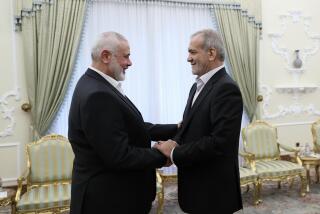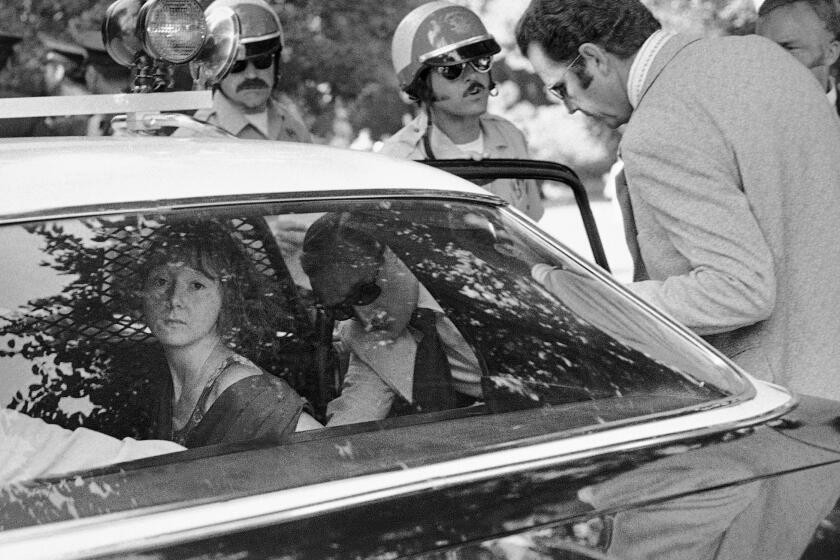Next Step : Palestinian Lands Becoming a State in All but Name : With Israeli pullout in the works, self-rule authority prepares to assume West Bank control.
“Hail our liberation!” reads the slogan inside Ismail Haj Ahmed’s hole-in-the-wall coffee-and-sweet shop off Janin’s crowded marketplace. “Welcome the Palestinian state!”
First painted amid enthusiasm for the historic peace accord between Israel and the Palestine Liberation Organization in September, 1993, the slogans have faded over the last year and a half with the general Palestinian disappointment at the slow implementation of that agreement.
Two weeks ago, however, the youngest of Haj Ahmed’s five sons, Ibrahim, 18, repainted the slogans at his father’s shop and added, “Janin next!”
“People feel that things are beginning to move again, that the Israelis will be gone in two, three, no more than four months, and we will have elections for our first Palestinian government by the end of summer,” said Abdullah Kamil, a local leader of Fatah, the mainstream Palestinian movement.
“And for Janin, it should happen a lot faster.”
Despite stop-and-go negotiations between Israel and the PLO and murderous attacks by Muslim radicals opposed to the peace agreement, the Palestinian Authority is preparing to assume control of the West Bank in July.
In those negotiations, in Israeli Cabinet decisions and in the PLO’s own plans, the foundations are being laid for an independent Palestinian state long sought by Arabs of the West Bank and Gaza Strip and the Palestinian diaspora.
The emerging elements:
* Broad PLO agreement with Israel on a Palestinian legislative council that will be elected, probably in September, to govern the West Bank and Gaza Strip. Members will be elected from districts on a proportional basis to ensure the inclusion of all factions. A council chairman, expected to be PLO leader Yasser Arafat, will be elected separately with power to appoint his ministers.
* Before the elections, the Palestinian Authority will take over more governmental functions in the West Bank, including labor, commerce and industry, insurance, energy, telecommunications and the postal service. New municipal councils will be established by the PLO in major towns. The Palestinian Authority assumed control of the Gaza Strip last May.
* New PLO efforts will be made to broaden the political base of the Palestinian Authority through discussions with opposition groups, including the Islamic Resistance Movement, known as Hamas, and others opposed to the agreement with Israel. PLO officials want maximum participation in the elections and say they are willing to change the draft electoral law to encourage it.
* A gradual redeployment, already beginning, of Israeli troops out of Palestinian towns and villages in the West Bank to areas around the 130 Jewish settlements in the region and along the roads leading to them. Target date for completing the pullback is late August.
* Israel is planning a “separation zone” between Israel and the West Bank, effectively establishing a border between the Jewish state and the Palestinian territories. Costing as much as $600 million just to establish, the zone will be patrolled by Israeli soldiers and police.
After more than 27 years of Israel’s occupation of the West Bank, the new “security line” would demarcate where Israel ends and where the Palestinian territories begin, which would constitute as much an acceptance of a Palestinian state as the earlier agreement on self-determination on the West Bank and Gaza Strip.
Under its unilateral plan, Israel would keep considerable territory captured in the 1967 Middle East War: East Jerusalem; a large corridor that stretches eastward toward Jericho, cutting the West Bank almost in half; the Gush Etzion group of Jewish settlements southwest of Jerusalem, and the Latrun Salient across which the Jerusalem-Tel Aviv highway now runs.
Most of the 130,000 Jews who have settled in the West Bank over the last quarter of a century, and who view the region as part of the biblical Land of Israel, will be left on the Palestinian side of the line.
“It does have political meaning,” Police Minister Moshe Shahal said of the controversial plan, drawn up at the request of Prime Minister Yitzhak Rabin. “It is defining that there are two entities. This is the reason why those who had a policy of annexation and who dream of a Greater Israel object to the idea. This means that it was just a dream and cannot be realized.”
Jewish settlements on the Palestinian side of the border immediately began bidding for the line to be redrawn so that they would on the Israeli side.
“We won’t agree to remain outside the fence,” said Shlomo Katan, the head of the Alfei Menashe settlement, which is in commuting distance from Tel Aviv but a couple of miles on the “wrong side” of the West Bank border.
Deputy Defense Minister Mordechai Gur said Israeli troops would be able to protect most Jewish communities even after they pull out of Palestinian towns and villages, but he warned that perhaps 30 of the 130 settlements would be too isolated to guard easily.
“(Settlement) construction was done with little planning and rather wildly on every hill and under every tree,” Gur said during a West Bank visit last week. Defense of the distant settlements would be difficult, he continued, “because we are talking about long, winding roads, hills and high mountains. . . . It’s very complex.”
The proposed security strip would range up to two miles wide and stretch 211 miles north to south, generally following the 1949 armistice line between Israel and Jordan. It would be patrolled by Israeli police and soldiers, using electronic devices to monitor movements across it and dogs and helicopters to track infiltrators. Watchtowers are planned for many hilltops along the route.
Eight to 10 checkpoints--in effect, border crossings--would be established for Palestinians entering Israel. Under an agreement reached last May but still not implemented because of Israel’s security concerns, Palestinians are permitted to travel between the Gaza Strip and the West Bank town of Jericho along four “safe passage” routes through Israel.
Only where Israeli and Palestinian villages are adjacent would Israel actually build a fence along the separation strip--a total of perhaps 20 miles--although it did build a security fence around the Gaza Strip last year.
“The separation plan of Minister Shahal will return us to our 1967 borders and open the way for a Palestinian state,” the opposition Likud’s Yehoshua Matza declared after Shahal had briefed members of the Knesset (Parliament). “He presents it as a virtual fait accompli, although there has been no (parliamentary) debate, not even Cabinet approval.”
Israeli forces are already pulling out of Janin, a town of 35,000 at the northern border of the West Bank. A big army checkpoint at the entrance to the town was dismantled this month, the local prison has been emptied, and only rarely do the remaining soldiers patrol the streets.
“Here is Janin, soon to be liberated,” Azmi Shuaibi, the youth and sports minister in the Palestinian Authority, told a gathering of Palestinian Scouts this month. “The Israelis are gathering up the debris of their occupation, and they are on the way out. It will be only days before details of their departure are known.”
At Haj Ahmed’s coffee shop, the regulars discussed the town’s prospects with both optimism and skepticism.
“We are ready to take control,” said Jalal Ahmed, who owns a clothing store. “Just let the Israelis go, and we will begin putting right their 27 years of damage and abuse. . . . It will be a great day when Arafat comes to Janin.”
To Nabil Masri, another merchant, “Janin first” is yet “another Israeli trick, another way of delaying what they agreed to and then reneged on.”
“As for Arafat and his council, they will have to prove they want to be democrats,” Masri said. “They have done nothing in Gaza. I am anxious for the Israelis to leave, but not for the PLO to come.”
In negotiations over the next phase of the autonomy agreement, Israel offered to turn over Janin and Bethlehem to the Palestinian Authority as an interim step, and the PLO countered with a call for Nablus and Ramallah instead.
Palestinian officials warn that such interim steps, although meant to bring momentum to a slow process, would have to be part of an overall agreement that would include troop redeployments up and down the West Bank.
Much remains to be done in the ultra-sensitive talks on the Israeli redeployment and on the Palestinian political system, but Israel and the PLO have set a July 1 deadline for signing an agreement.
Yoel Singer, legal adviser to the Israeli Foreign Ministry and chief Israeli negotiator on political issues, has expressed confidence that, barring a breakdown because of further terrorist attacks, an agreement will be ready along with plans for the elections and the redeployment.
“Instead of talking . . . we are writing,” Singer said. “Clause after clause, the agreement is starting to take form.”
Saeb Erekat, the Palestinian municipal affairs minister, said several important questions must still be resolved: the size of the legislative council, qualifications of candidates and their commitment to the peace process and the right of Jerusalem residents to participate in the elections.
Even then, the immense political, administrative and financial difficulties the PLO has encountered in the Gaza Strip are a warning of further troubles.
Lastly, the negotiations on such tough questions as the status of Jerusalem, the future of Jewish settlements in the Palestinian territories and the return of Palestinian refugees do not begin until May, 1996, and it could take three years or more before all issues are resolved.
But few political observers disputed the assessment of Yossi Sarid, Israel’s dovish and outspoken environment minister, that the establishment of a Palestinian state is well under way.
“Following the election in the territories, a Palestinian state will be established,” Sarid said. “It will not be officially called a state, but de facto it will be a state. . . . Although the separation line between Israel and the Palestinians is a security line, it gives the first clear idea as to what the borders of the Palestinian state will look like.”
Although the right wing objected loudly to Sarid’s remarks and Rabin distanced himself from them, commentators noted that Israel increasingly treats the Palestinian Authority as “an autonomy-plus or a state-minus.”
Most Israelis, however, already believe that a Palestinian state will result from the peace process. According to an opinion survey published recently by Yediot Aharonot, Israel’s largest paper, 73% of those surveyed replied “yes” when asked if the current negotiations will bring an independent Palestinian state.
Israel, in fact, is only barred from acknowledging the emergence of an independent Palestine by the hope, however diminished, that at the conclusion of negotiations, Jordan and Palestine will form a confederation.
Rabin now meets with Arafat as a fellow head of government, and Israel’s Foreign Ministry has an “autonomy department” for the Palestinian territories, just as it has a North American department for the United States and Canada.
Even more to the point, Israel makes the same security demands of the Palestinian Authority that it has of its other Arab neighbors over the years--that no terrorist attacks come from its territory--in an implicit recognition of Palestinian sovereignty.
“The Palestinian state already exists today in the Gaza Strip and in (the West Bank town of) Jericho, and this is the most important fact that the Rabin government has settled in the peace process,” Aluf Ben wrote in the newspaper Haaretz last week.
“The Palestinian Authority of Yasser Arafat is in practice a state, even if for tactical reasons it is convenient for Israelis, Palestinians and the international community to ignore this for the time being and envelop themselves in agreed lies about autonomy.”
More to Read
Sign up for Essential California
The most important California stories and recommendations in your inbox every morning.
You may occasionally receive promotional content from the Los Angeles Times.






